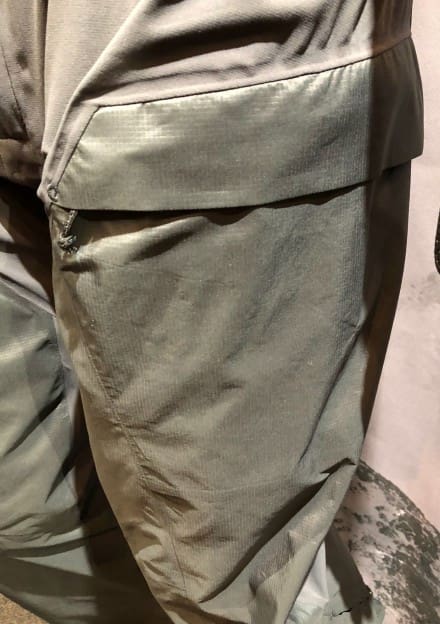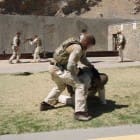In this final installment of our series on The Lost Arrow Project’s Military Alpine Recce System, I wanted to take a deep dive on two garments. While the entire system was a ground up reboot of environmental clothing systems and packed with innovative concepts, these two jacket and pant combinations exhibit the systems’ departure from the status quo.
Earlier I referred to MARS as a take out menu and I believe that the Pnuemo Fuse and Mixed Range will be the most popular pieces in MARS, serving as the definition of what Patagonia designer Casey Shaw aspired to when he pondered how to make one garment replace six others.
Pnuemo Fuse
USSOCOM’s Protective Combat Uniform was designed from a seven level template codified by Mark Twight in his book “Extreme Alpinism: Climbing Light, Fast and High.” His level five is referred to as an “Action Suit.” Unfortunately, the PCU level 5 garment never seemed to live up to what I saw in my mind’s eye. The material could be hot at times and lacked the comfort level of something that might be worn day-in and day-out.
The Pneumo Air garment in MARS on the other hand fits it to a “T.” I look at it and think comfort. It also makes me think of the clothing on science fiction shows. It’s like what Space Marines will wear in the future, except it’s available now; a great combination of design and materials.
It’s definitely a three-season garment and so long as you’re in a Temperate zone, you could get away with wearing this all year. The fabric is so cozy, I think you’ll want to. I can see operators wearing this all the time while deployed, whether in the field, on the FOB lounging, or conducting PT. In one of the solid colors (Fatigue Green or Forge Grey), they’ll even wear it while off duty at home station as well.
The material is unique to MARS. It’s a reversed block knit (aka gridded fleece) laminated to Aerolite nylon face fabric which is common across most of the MARS garments. In the chest area on Pneumo Fuse, the two fabrics are used together, but not laminated.
The name of the garment alone tells you what is going on. This material selection offers a high degree of air permeability (40 CFM) which is great while active as the block knit has recesses which traps a layer of boundary air which serves as insulation when static. The lamination also reduces bulk yet doesn’t reduce air permeability or compromise the integrity of fabric.
The uniform also offers a DWR coating and elasticize hem and cuffs. The helmet compatible hood adjusts with a concealed cord to avoid snagging.
Wherever possible, the seams use ultrasonic welding and are backed with 11mm seam tape. Additionally, they’re reinforced with ForgeLine, an X-stitch pattern developed in Patagonia’s R&D facility, The Forge.
Across the board, pockets are kept to a minimum with front slash pockets in the pants along with a side patch pocket while the jacket incorporates handwarmer pockets.
Mixed Range
Like Pneumo Air, Mixed Range is a huge departure from what’s currently available. It’s a hybrid garment which combine hard and soft shells. Granted, these are nothing new, but how The Lost Arrow Project created this garment is a bit different. It’s a combination of their 3-layer waterproof breathable fabric called H2No Air and a treated version of the Aerolite fabric which serves as a highly breathable soft shell.
In this case, they’ve made the horizontal surfaces waterproof, including elbows, knees and lower legs, while the vertical surfaces are features soft shell fabric including the chest, back, and crotch. In both cases the fabrics offer some stretch.
An interesting feature across both Mixed Range and Pneumo Fuse is the integrated belt, despite incorporating low profile belt loops for use with life support capable belts when needed. The belt loops are low bulk and don’t create friction points which can rub the wearer. Finally, the gusseted zippered cuffs fit over boots and feature tie-down loops.
Like the Pneumo Air, the Mixed Range features ultrasonic welding and narrow seam tape along with ForgeLine for reinforcement.
Once again, pockets remain few, yet functional, like this thigh pocket.
The pant also incorporates a zippered lower leg to assist with donning and doffing.
For this, and other garments in MARS, Patagonia developed a Berry compliant Touch Point System cord lock which is embedded in the garment. The helmet-compatible hood cord adjustments are concealed and the excess fits into a drainable garage at the rear of the hood.
Conclusion
Both garments are impressive and I expect will be adopted for use in greater numbers than full kits, as Patagonia rolls out their product options. They offer a great deal of versatility, being useful in a wide variety of climates.
This is the final installment of a four-part series on the Military Alpine Recce System developed by Patagonia’s The Lost Arrow Project. Earlier installments include the history of Patagonia’s SOF support, a system overview and a focus on the production partner, Peckham Vocational Industries. The full system will be on exhibit at SOF Select during SOFIC.








































































































































